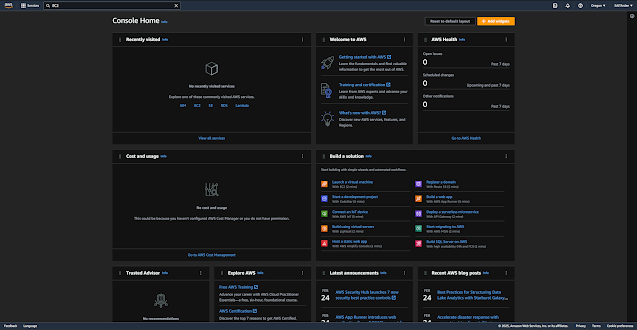What is AWS Cloud Computing?
What is AWS Cloud Computing?
AWS Cloud Computing is a cloud service from Amazon which offers ranges of IT services to help store, process and manage data. It can create and launch any type of application in the cloud. This service was launched by Amazon in 2006 and has been the most popular and used Cloud Computing platform.
Generally,
AWS Cloud used in a wide range of industries and by millions of customers
worldwide. This includes, startups, small to medium-sized businesses and large
enterprises. For industries it is beneficially used in healthcare, finance, e-commerce,
and plenty more of other businesses.
Types of Cloud Computing and Deployment Models
Infrastructure as a Service (IaaS): This service provides virtualized computing resources such as servers, storage, and networking. IaaS can be used to create and manage virtual machines, operating systems (OS) and applications.
Platform as a Service (PaaS): PaaS is the deployment and management of applications allowing users to build, run and manage applications without having to worry about the underlying infrastructure.
Software
as a Service (SaaS): SaaS is essentially a completed product
that is run and managed by a service provider which is also referred to
End-User Application. Customers can access and use the application
through a web browser or API.
Deployment Models
Cloud as it says in the name, is a cloud-based application that is fully deployed in the cloud. Having all parts of the application created and run in the cloud from an existing infrastructure.
Hybrid deployment combines the benefits of public and private cloud environments. These deployment models are a benefit to both public and private clouds because it extends and grows an organization's infrastructure into the cloud while connecting cloud resources to internal systems.
On-premises are normally called "private cloud" also known as AWS Outposts which is a fully managed service that helps organizations run AWS infrastructures on-premises. Having their own data centers, AWS Services, APIs, and tools.
What services are offered by AWS?
- Compute
- Storage
- Database
- Networking & Content Delivery
- Analytics
- Machine Learning
- Security, Identity, & Compliance
You can also check the rest of the information of the products by clicking here!
Compute: AWS Cloud Compute provides scalable computing resources in the cloud. It includes Virtual Machines, containers, and serverless computing services allowing customers to run applications and workloads in a flexible and cost-effective manner. AWS Cloud Compute also includes a range of other services like, auto-scaling, load-balancing, improve performance, reducing costs and many more. The product is pay only for what you use which we will go in depth more later.
What services are provided in Compute?
- Amazon Elastic Compute Cloud (Amazon EC2)
- AWS Lambda
- Amazon Elastic Container Service (Amazon ECS)
- Amazon Elastic Kubernetes Service (Amazon EKS)
- Amazon LightSail
AWS Lambda: Lambda is a serverless computing service that allows customers to run code without having to manage servers.
Amazon Elastic Container Service (Amazon ECS): This service is a fully managed container orchestration that allows customers to run, stop, and manage containerized applications
Amazon Elastic Kubernetes Service (Amazon EKS): Kubernetes Service is a fully managed that makes it easy to deploy, manage and scale containerized applications
Amazon LightSail: LightSail is a cloud platform that offers pre-configured Virtual Private Server (VPS). It's easy to use and it's designed to quickly launch and manage applications.
Advantages and Uses of AWS Cloud Compute
You can use AWS Cloud Compute in a wide range of industries. They're commonly used in Web and Mobile Applications, Data and Analytics, Machine Learning and AI, DevOps and Development and Gaming!
So
why do we use AWS Cloud Compute?
Flexibility
AWS
Cloud Compute's flexibility provides great computing services, tools to
optimize and manage their computing resources. Having elastic compute, auto
scaling, containerization, and the ability for users to choose the right
services. This allows users to easily adjust computing resources to their
application.
Cost-Effectiveness
The
cost-effectiveness can vary depending on what services are used and what
deployment model are launched. AWS provides a Pay-as-you-go pricing meaning the
users only pay for the resources that they consume. It still does help users
save money because it is much more effective to use their service than using
the on-premises infrastructure where you must purchase and maintain hardware.
Scalability and Performance
The
scalability of AWS Cloud Compute provides users the ability to scale their
compute resources quickly and easily. Again, depending on what services you
use, you can scale your application up or down and provide fast and reliable
service.






Comments
Post a Comment